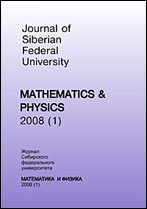|
Physical basis of quasi-optimal seismoacoustic pulse generating for geophysical prospecting in shallow water and transit zones. Part 2. The layout of aqueous seismic source and the results of experiments
Danil S. Kudinova, Oleg A. Maykova, Pavel V. Balandinb
a Siberian Federal University, Krasnoyarsk, Russian Federation
b LLC Evenkiyageofizika, Tyumen, Russian Federation
Abstract:
The article discusses theoretical aspects of seismic wave excitation of in the aquatic environment, addresses the problems of instrumental implementation of a fundamentally new source of seismic vibrations that can work: in the water area, in tidal and coastal zones. The scientific substantiation of the developed seismic source (SS) design is given.
The results of the seismic influence simulation of hydrodynamic resistance on the media, as well as the formation of the “added mass” are given. The results were obtained using the developed mathematical model of the motion of the radiating surface. Based on the experimental work, a comparative analysis of the energy efficiency of the developed seismic source model and the serial sample of the VEM-50 "Yenisei" water seismic source was made. Experimental results were obtained at the geophysical well of the test and training area.
Keywords:
seismic source, seismoacoustics, pseudorandom sequence, scrambling sequence, shallow water, transit zone.
Received: 09.09.2019
Received in revised form: 03.11.2019
Accepted: 20.12.2019
Citation:
Danil S. Kudinov, Oleg A. Maykov, Pavel V. Balandin, “Physical basis of quasi-optimal seismoacoustic pulse generating for geophysical prospecting in shallow water and transit zones. Part 2. The layout of aqueous seismic source and the results of experiments”, J. Sib. Fed. Univ. Math. Phys., 13:1 (2020), 71–78
Linking options:
https://www.mathnet.ru/eng/jsfu819 https://www.mathnet.ru/eng/jsfu/v13/i1/p71
|

| Statistics & downloads: |
| Abstract page: | 180 | | Full-text PDF : | 41 | | References: | 25 |
|




 Contact us:
Contact us: Terms of Use
Terms of Use
 Registration to the website
Registration to the website Logotypes
Logotypes









 Citation in format
Citation in format 